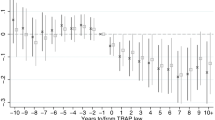Abstract
This study empirically examines whether restrictive state abortion laws have an impact on the number of abortion providers over the period 1982–2005. The empirical results find that medicaid funding restrictions, parental involvement laws and targeted regulation of abortion providers (TRAP laws) annual licensing fees significantly deter physicians or organizations from becoming or remaining abortion providers. The numerical impact of a Medicaid funding restriction, parental involvement law and a TRAP licensing fee is to reduce the number of abortion providers per 100,000 pregnancies by 12.8, 19.6 and 15.5, respectively, as compared to states without these restrictive abortion laws. The empirical results also show that parental notification laws have a significantly larger negative impact on the number of abortion providers than parental consent laws.
Similar content being viewed by others
References
Bitler, M., & Zavodny, M. (2001). The effect of abortion restrictions on the timing of abortions. Journal of Health Economics, 20(6), 1011–1032.
Blank, R. M., George, C. C., & London, R. A. (1996). State abortion rates: The impact of policies, providers, politics, demographics, and economic environment. Journal of Health Economics, 15(5), 513–553.
Erikson, R. S., Wright, G. C., & McIver, J. P. (1993). Statehouse democracy. Cambridge, UK: Cambridge University Press.
Feminist Majority Foundation. (2000). 1999 clinical violence survey report. Arlington, VA: Feminist Majority Foundation.
Finer, L. B. (2007). Trends in premarital sex in the United States, 1954–2003. Public Health Reports, 122, 73–78.
Goggin, M. L. (1993). A framework for understanding the new politics of abortion. In M. L. Goggin (Ed.), Understanding the new politics of abortion (pp. 1–17). Newbury Park, CA: Sage Publications.
Guttmacher Institute. (2006). State policies in brief. New York: Alan Guttmacher Institute.
Jelen, T. (1991). The political mobilization of religious beliefs. New York: Praeger.
Jones, R. K., Zolna, M. R., Henshaw, S. K., & Finer, L. B. (2008). Abortion in the United States: Incidence and access to services, 2005. Perspectives on Sexual and Reproductive Health, 40(1), 6–16.
Levine, P. B. (2003). Parental involvement laws and fertility behavior. Journal of Health Economics, 22(5), 861–878.
Matthews, S., Ribar, D., & Wilhelm, M. (1997). The effects of economic conditions and access to reproductive health services on state abortion rates and birthrates. Family Planning Perspectives, 29(2), 52–60.
Medoff, M. H. (2007). Price, restrictions and abortion demand. Journal of Family and Economic Issues, 28(1), 583–599.
Merz, J. F., Jackson, C. A., & Klerman, J. A. (1995). A review of abortion policy: Legality, Medicaid funding and parental involvement, 1967–1994. Woman’s Right’s Law Reporter, 17(1), 1–61.
NARAL Foundation. (1991 and various years). A state-by-state review of abortion rights. Washington, DC: NARAL Foundation.
Schnell, F. (1993). The foundations of abortion attitudes: The role of values and value conflict. In M. L. Goggin (Ed.), Understanding the new politics of abortion (pp. 23–43). Newbury Park, CA: Sage Publications.
U.S. Bureau of the Census. (1999, 2006). Statistical abstract of the United States. Washington, DC: Government Printing Office.
U.S. Bureau of the Census. (1983, 1993, 2003). U.S. Census of Population, State reports. Washington, DC: Government Printing Office.
Author information
Authors and Affiliations
Corresponding author
Rights and permissions
About this article
Cite this article
Medoff, M.H. The Relationship Between State Abortion Policies and Abortion Providers. Gend. Issues 26, 224 (2009). https://doi.org/10.1007/s12147-009-9085-9
Published:
DOI: https://doi.org/10.1007/s12147-009-9085-9



